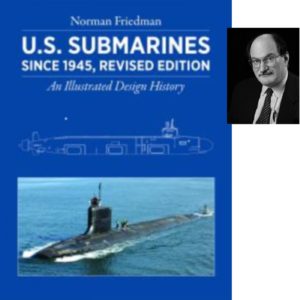Podcast: Play in new window | Download
Subscribe: RSS

This is my second interview with naval historian Norman Friedman. He’s written extensively on US and British naval forces and in this episode I spoke to him about his latest book, a revised edition of his book on US submarines since 1945.
2:05 – Norman first talks about why he wrote on submarines.
3:45 – Since the end of the Cold War, the US has dealt more with rogue states and subs aren’t engaged much in that. However, subs are good at collecting intelligence and moving special forces.
6:33 – Submarines have installed much stronger computers to process information.
9:30 – We discuss computer systems aboard submarines.
11:51 – We talk about how German experiences in WWII affected how the US approached subs.
13:30 – The Navy had heavy bombing aircraft originally to bomb enemy sub bases.
16:37 – The US was trying many different engines before designing nuclear propulsion.
20:05 – Norman talks about the Scorpion accident. He also talks about the Thresher accident.
25:00 – Some sub related documents disappear because of the sheer amount of documents out there.
30:45 – Norman talks about sub deep-sea operations.
41:36 – In the book, Norman also talks about why things were used or changed on the subs.
51:15 – The conference in the 1950s to build a new kind of sub was unique.
For more “Military History Inside Out” please follow me on Facebook at warscholar, on twitter at Warscholar, on youtube at warscholar1945 and on Instagram @crisalvarezswarscholar
Guests: Norman Friedman
Host: Cris Alvarez
Tags: military, history, military history, conflict, war, interview, non-fiction book, US, Navy, submarines, British Navy, Scorpion, Thresher, attack subs, WWII, world war two
